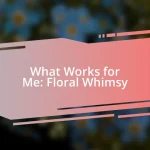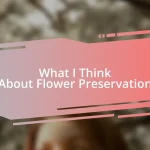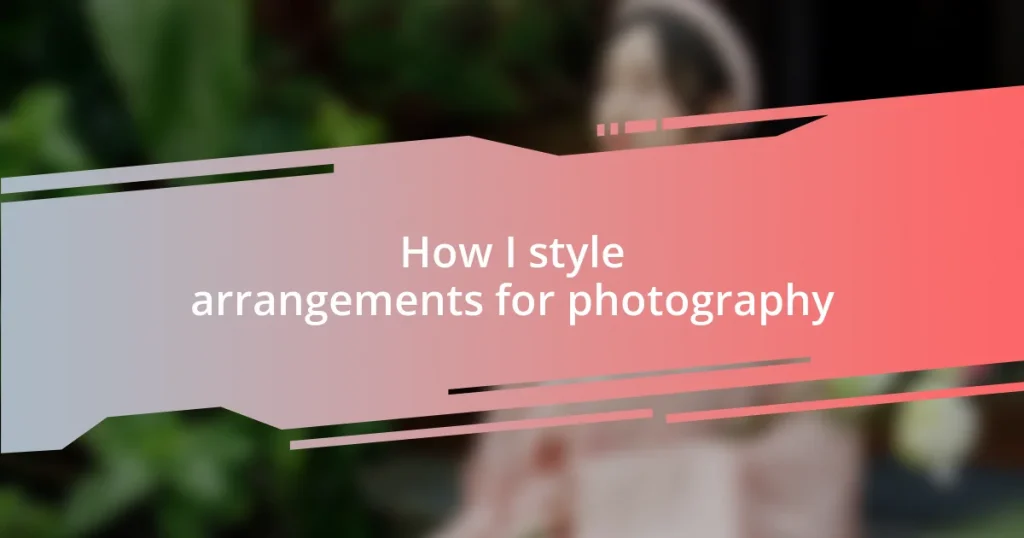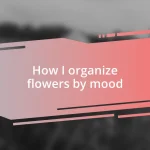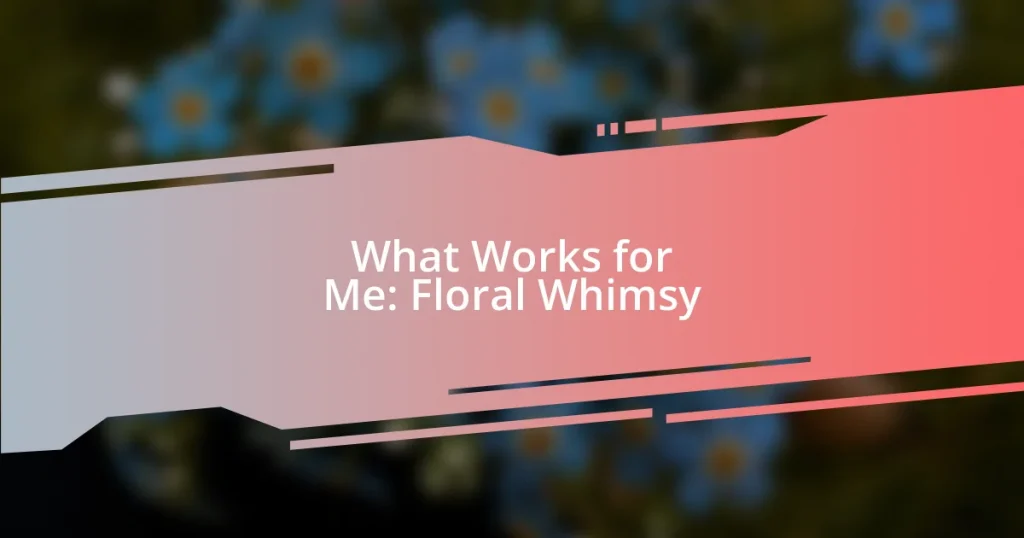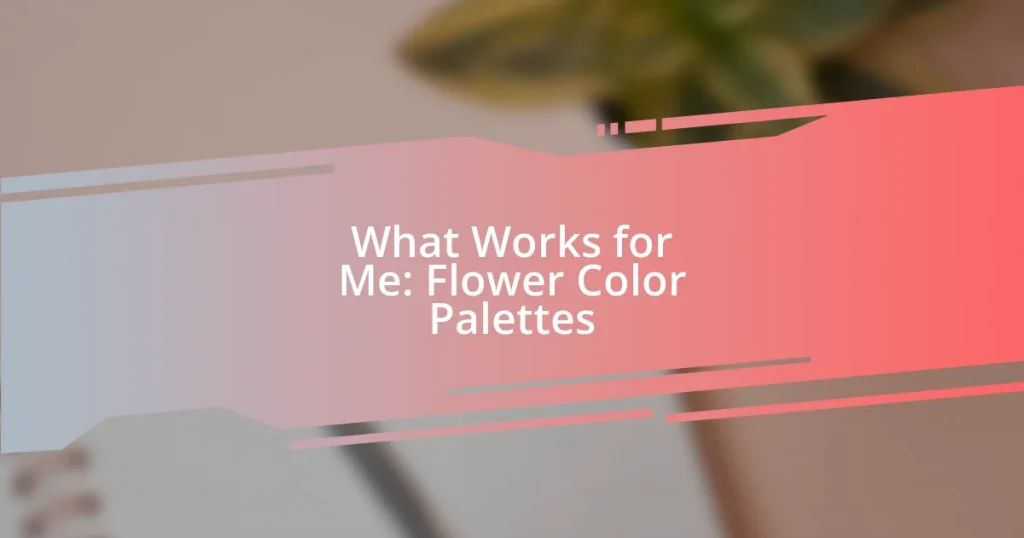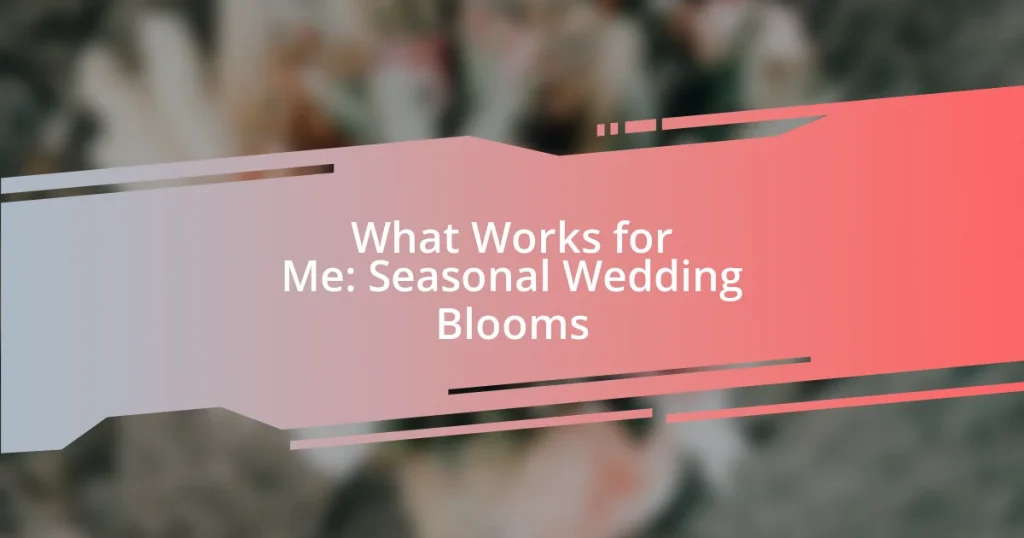Key takeaways:
- Choosing an arrangement style based on mood can enhance the emotional essence of photographs, with options ranging from organic to minimalist designs.
- Mastering lighting techniques, including natural and artificial sources, is crucial for creating the desired atmosphere and adding depth to images.
- Finalizing a scene by carefully arranging props, minimizing distractions, and paying attention to lighting can significantly elevate the overall impact of a photograph.
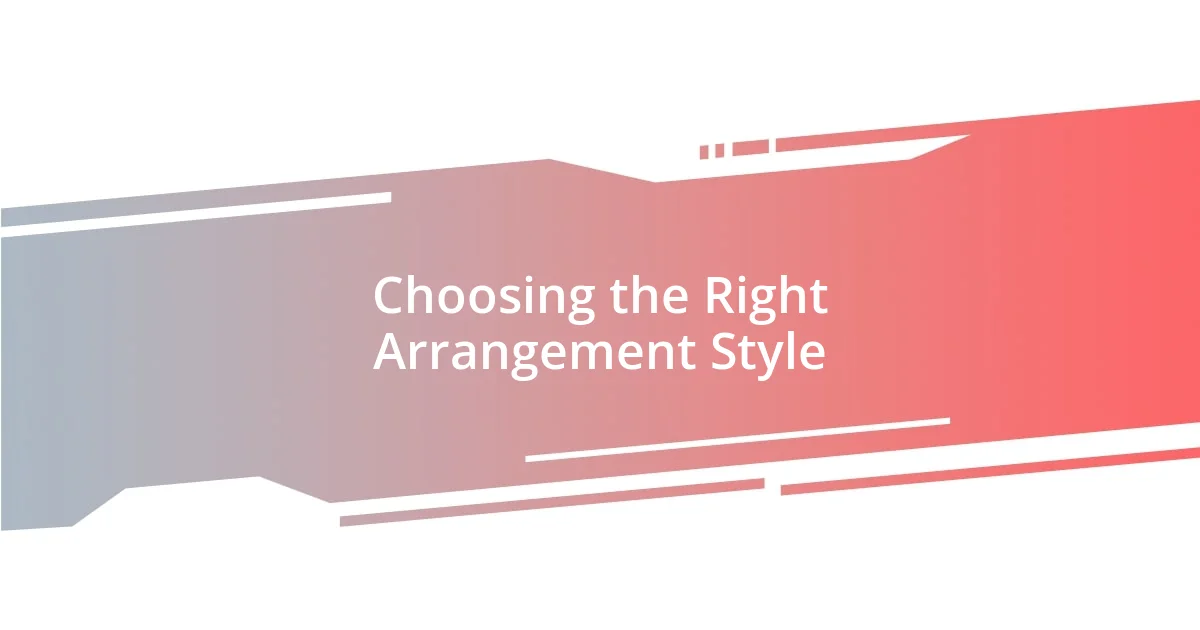
Choosing the Right Arrangement Style
When choosing the right arrangement style, I often reflect on the mood I want to convey. Recently, while arranging flowers for a friend’s wedding, I went with a loose, organic style that echoed the romance of the day. It made me consider how much the right arrangement can elevate the emotion behind a moment, don’t you think?
I remember a photoshoot where I opted for a minimalist arrangement, using only a few carefully selected pieces. The clean lines and negative space drew the viewer’s eye to the subjects—my friends’ laughter and joy at that moment. It reminded me that sometimes less really is more and that the right style amplifies the essence of the scene.
When selecting an arrangement style, I always ask myself, “What story do I want to tell?” I believe each choice shapes the narrative. For instance, I’ve found that vibrant, cascading arrangements work wonders for lively celebrations, while structured, symmetrical designs lend themselves beautifully to more formal settings. Each choice not only reflects the event but also adds depth to the photographs captured.
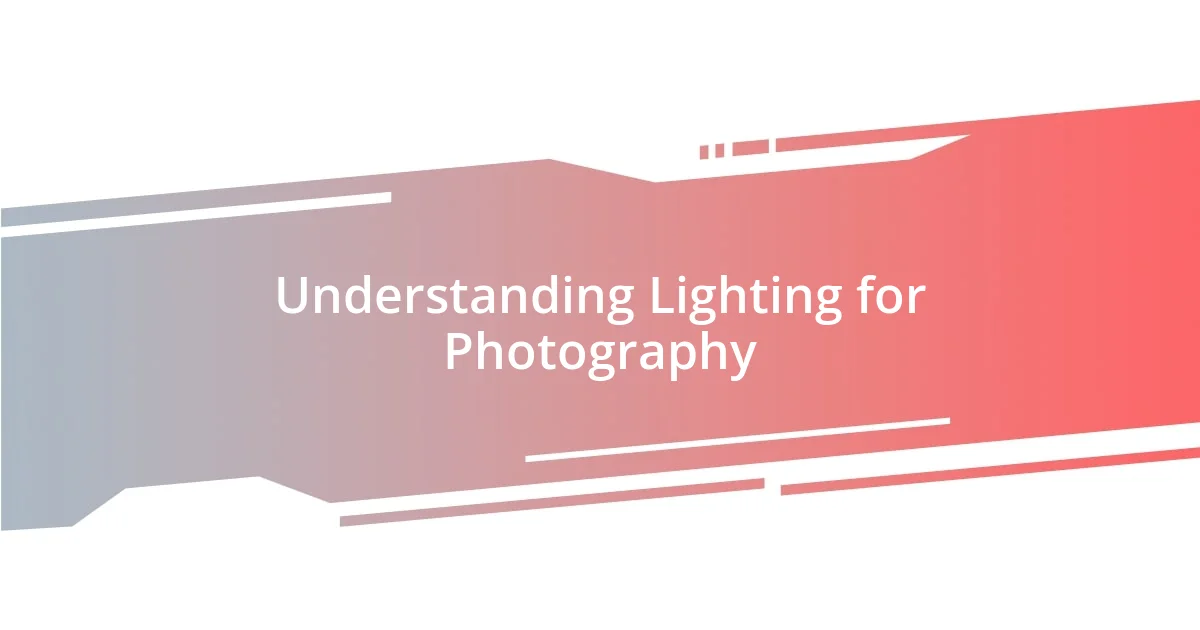
Understanding Lighting for Photography
Understanding lighting in photography is fundamental to capturing the desired atmosphere and emotion. I recall a time when I was experimenting with natural light during a golden hour shoot. The way the soft, warm glow wrapped around my subject created a magical feel, enhancing the overall beauty of the image beyond what I had imagined. It truly underscored for me how crucial lighting can be in painting the mood of a photo.
When considering different light sources, here are a few key points to remember:
- Natural Light: Often provides a soft and flattering effect. The golden hour, just before sunset, is particularly enchanting.
- Artificial Light: Allows for control and consistency. I often use softboxes or LED panels to mimic natural sunlight.
- Direction of Light: Side lighting can add depth and dimension, while backlighting creates striking silhouettes. I once used backlighting during a portrait session, which transformed the image entirely.
- Color Temperature: Different sources emit varying colors of light. Warmer tones can evoke feelings of warmth, while cooler tones tend to convey calmness. Adjusting my camera settings to match the desired mood is something I’ve learned to prioritize.

Selecting Props and Backdrops
When it comes to selecting props and backdrops, I emphasize the importance of relevance and storytelling. For instance, I once chose a vintage suitcase as a prop for a travel-themed shoot, which instantly transported the atmosphere and tied the whole composition together. Choosing elements that resonate with the theme elevates not just the arrangement but also the narrative the photo tells.
Backdrops can either enhance or detract from your subject. A cluttered background can overshadow the main focus, while a simple, textured backdrop can add depth without competing for attention. I remember using a weathered wooden wall during a family portrait session; it perfectly complemented their casual yet warm vibe, making the photo feel inviting. The right backdrop truly sets the stage for what you want to convey.
Additionally, props allow for personalization and creativity. I advise selecting items that reflect the personalities of the subjects involved. During a recent engagement shoot, I incorporated some meaningful books a couple cherished. Not only did they serve as beautiful props, but they also added a personal touch that helped express their story. Balancing aesthetics with sentiment is key in crafting a visually appealing photograph.
| Type | Characteristics |
|---|---|
| Natural Backdrops | Provide organic beauty, such as gardens or parks; evoke feelings of tranquility. |
| Textured Fabrics | Add depth and richness, available in various colors; perfect for enhancing subjects. |
| Personal Props | Connects emotionally; highlights unique stories of subjects. |
| Seasonal Elements | Reflect time of year, such as autumn leaves or spring flowers; creates a thematic link. |
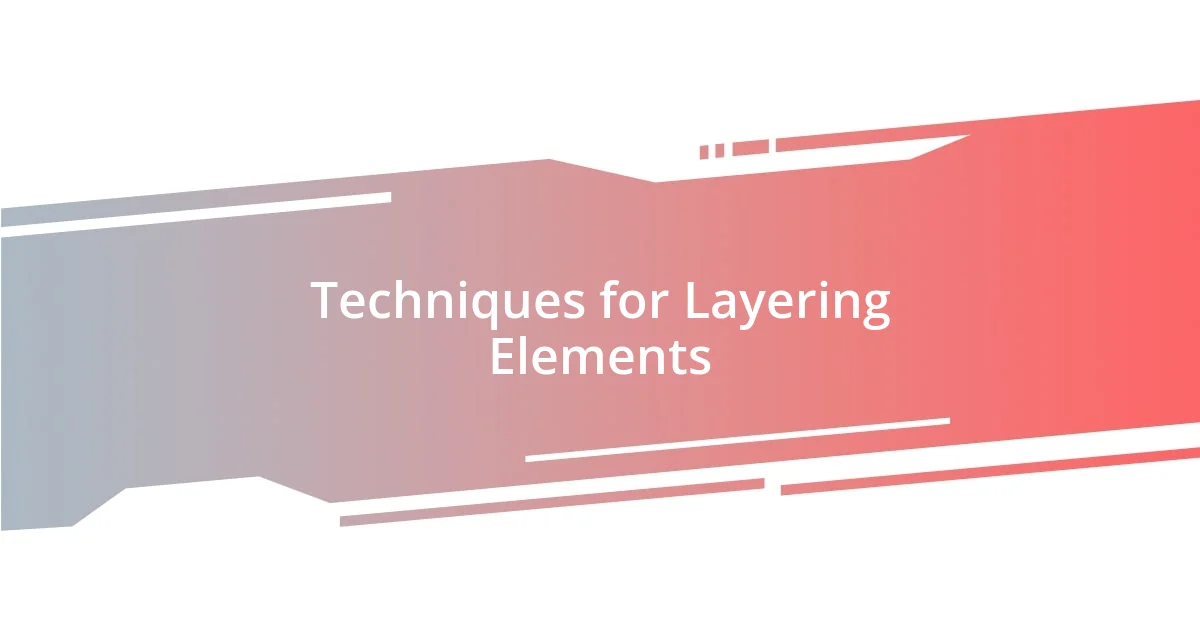
Techniques for Layering Elements
Layering elements in photography can transform a simple composition into a visually dynamic experience. I remember a time when I layered foreground elements, like flowers, with a model in the mid-ground and a scenic backdrop behind them. This technique turned a static shot into a captivating visual journey, drawing the viewer’s eye through the layers. It adds depth and context, making the photograph feel more three-dimensional.
One effective method I often use involves varying the sizes of the elements. Placing a larger object, like a tree, alongside smaller props, such as rocks or flowers, creates a sense of scale that fascinates the viewer. For instance, during a recent outdoor shoot, I positioned my subject next to oversized sunflowers, which not only made her appear more delicate but also highlighted the warm, summery vibe of the day. How do you think scale changes the perception of a photograph?
Another approach is to use negative space wisely to provide breathing room for the layered elements. I once shot a model against a vast expanse of sky, ensuring that there was ample empty space around her. This choice emphasized her presence while still integrating the backdrop, creating a serene, airy feel. Considering how your subject interacts with the space around them can significantly elevate the overall composition. It prompts the viewer to not just see the elements, but to feel them.
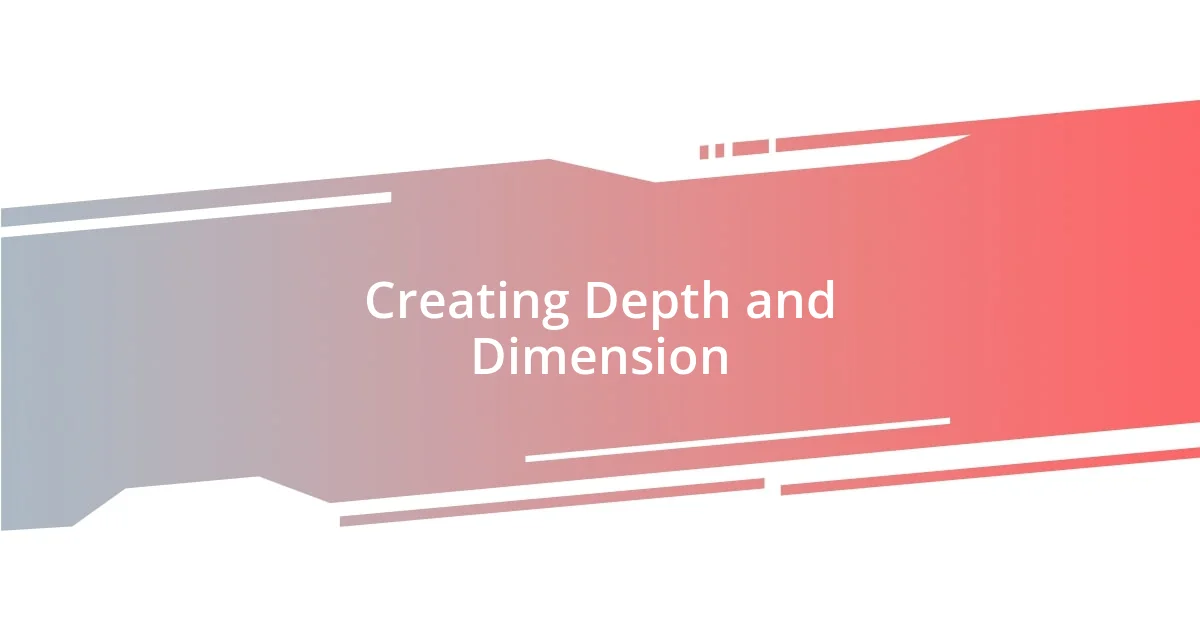
Creating Depth and Dimension
Creating depth in photography can truly elevate your images. One fascinating method I love is utilizing leading lines, which guide the viewer’s eye. While setting up a recent landscape shoot, I positioned myself near a winding path that led into the distance. The path created a natural line, making the viewer feel like they could almost step into the scene. Doesn’t that make you wonder how much more engaging a photograph can become with just a slight adjustment in your composition?
Incorporating layers also plays a significant role in crafting dimension. I remember one family shoot where I had the kids stand in the foreground with their parents placed further back in a field. This layering technique didn’t just showcase their expressions but also told a story of togetherness. The distance made the moment feel intimate yet expansive at the same time. How do you think different placements can change the perception of family dynamics in a picture?
Experimenting with perspective can also add incredible depth. I once captured a whimsical shot of a child blowing bubbles on a nearby shore, getting low to the ground to emphasize their tiny figure against the vast ocean. This shift in perspective not only heightened the subject’s innocence but also engaged viewers, making them feel included in the moment. Have you ever thought about how simply changing your viewpoint could transform the entire mood of an image?
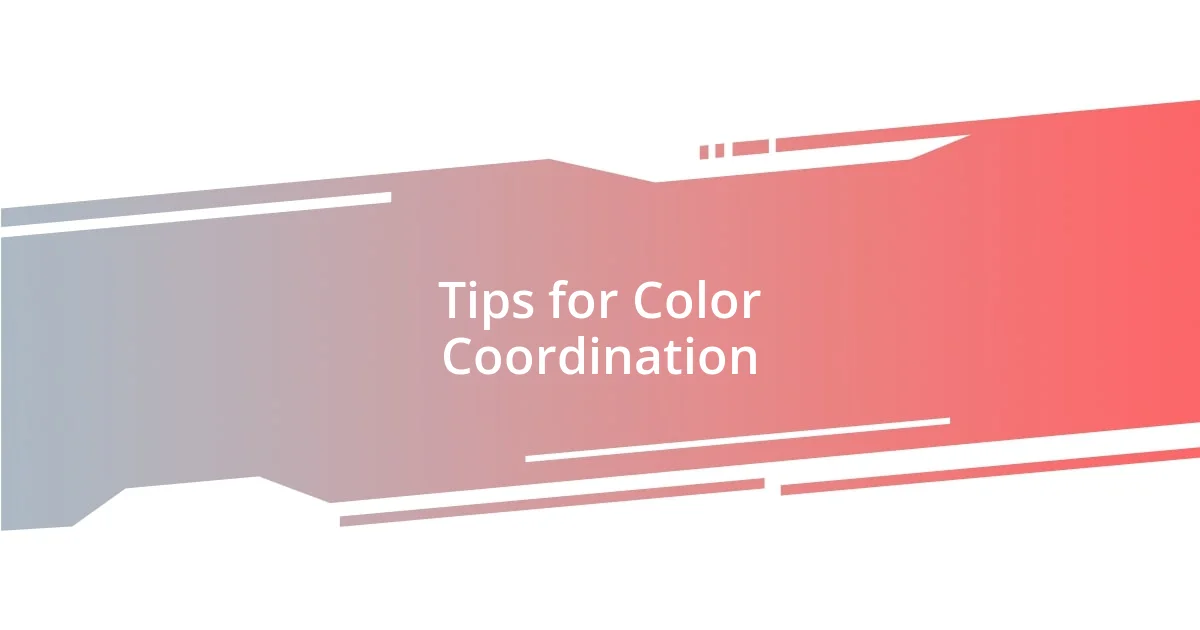
Tips for Color Coordination
When it comes to color coordination in photography, I have learned that creating a harmonious palette can significantly enhance the overall mood of the image. For example, during a recent engagement shoot, I chose a backdrop of soft pastels, which perfectly complemented the couple’s outfits. The delicate pinks and blues not only made the couple pop but also evoked a romantic and dreamy atmosphere. Have you ever noticed how certain colors can evoke specific emotions?
I personally believe that contrasting colors can also create a striking visual impact. Once, while working with a vibrant red dress against a lush green landscape, the combination was so powerful that it almost felt like the colors were dancing together. This bold contrast drew all eyes to the subject, ensuring she was the focal point amid the action around her. When you think about your own shoots, how can you play with contrasting colors to bring out your subject’s character?
Lastly, I always pay attention to the color temperature of the light in my photography. Choosing warm tones in the golden hour creates an inviting, soft glow, while cooler tones can invoke a more dramatic feel, as I discovered when photographing a snowy winter scene. I found that the deep blue tones of twilight against the white snow added a layer of serene beauty to my images. What kind of emotions do different lighting scenarios bring out in the colors of your subjects?
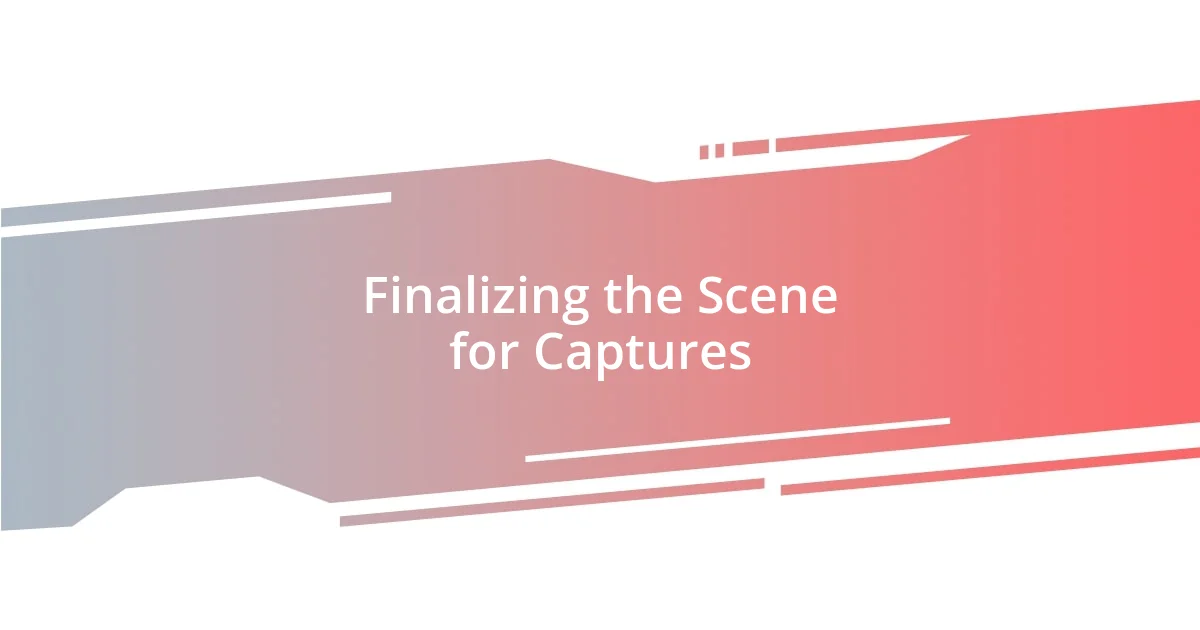
Finalizing the Scene for Captures
Getting the perfect final touches on a scene can make all the difference during a shoot. I recall a sunset beach session where I spent a few extra minutes shifting a few pieces of driftwood into the frame. This simple adjustment added a natural touch that drew the eye, guiding viewers toward the couple happily strolling along the shore. Don’t you think it’s fascinating how small elements can significantly enhance the story you’re telling through your lens?
Lighting, too, is a crucial part of finalizing any scene. During one of my urban shoots, an unexpected break in the clouds revealed the sun’s soft rays just as my models posed beneath an urban archway. The light hit perfectly, casting gentle shadows that added depth without overwhelming the subject. Have you ever found that magical moment when everything aligns just right—a moment that transforms the entire shoot?
Also, don’t underestimate the importance of decluttering your scene. Recently, while shooting a candid family moment in a park, I noticed a stroller peeking into the frame. By stepping to the side for a clearer shot, I maintained the candidness but ensured no distractions took away from their joy. Isn’t it amazing how clarity can elevate the emotional impact of an image?
